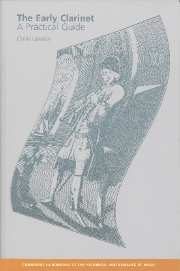4 - Playing historical clarinets
Published online by Cambridge University Press: 22 September 2009
Summary
Introduction
The clarinet underwent a remarkable transformation during the century which separated the publication of Carl Baermann's Vollständige Clarinett-Schule from Roeser's Essai d'instruction of 1764. Indeed, the instrument moved from the periphery of art music to a position of preeminence amongst the orchestral winds. This chapter examines the principal primary sources for playing technique, with particular emphasis on methods currently available in facsimile or reprint, such as those by Roeser, Vanderhagen, Lefèvre, Backofen, Fröhlich, Müller, Klosé and Baermann. They contain advice on many issues, including posture, embouchure and reed-position, articulation, fingering, reed selection and maintenance, care of the instrument, ornamentation, and other practical and aesthetic consideratons.
The sheer variety of approaches within these sources provides a stark contrast with the homogeneity and standardisation of our own age. It is essential to bear in mind that many tutors were written in answer to the requirements of an assortment of musicians, including advanced players, beginner clarinettists, musical novices, composers and multi-instrumentalists. Although these sources are useful and informative, we cannot afford to allow ourselves to be too entranced or enslaved by their directions, hints, rules and suggestions.
Posture
One of the earliest representations of a clarinettist is the engraving by the Nuremberg artist Johann Christoph Weigel. The depiction, from a set entitled Musicalisches Theatrum, c. 1722, portrays a fashionably smart man in an elegant room, playing a two-keyed clarinet whilst standing astride on a platform.
- Type
- Chapter
- Information
- The Early ClarinetA Practical Guide, pp. 41 - 62Publisher: Cambridge University PressPrint publication year: 2000

